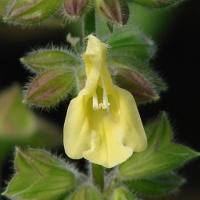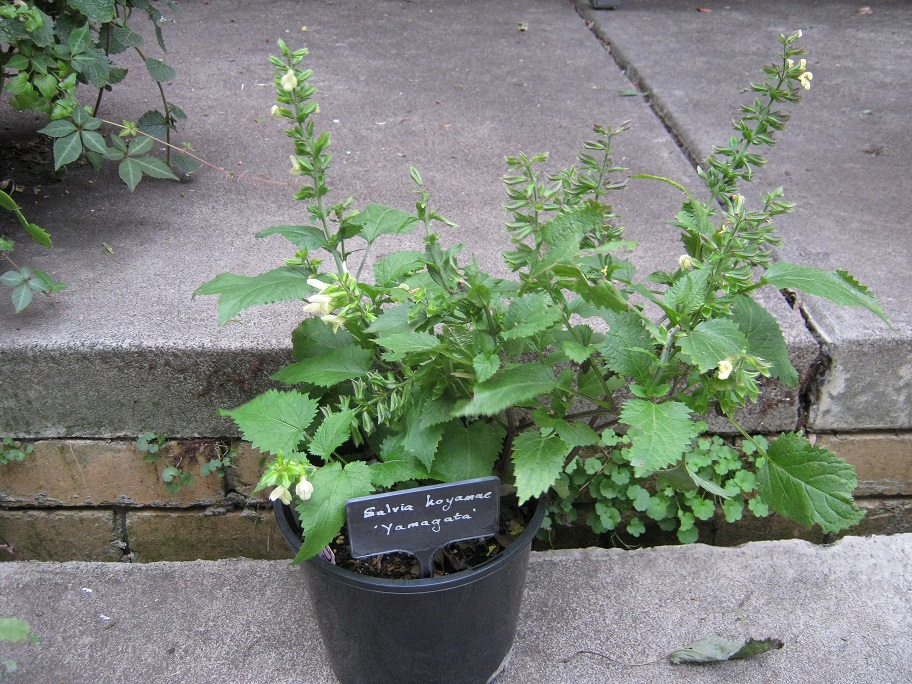Yellow Japanese Salvias
Yellow Japanese Salvias
Yellow Japanese Salvias
Yellow Japanese Salvias
JAPANESE SALVIAS
- glutinosa
- nubicola
- koyamae
- campanulata
- Crug’s Cream
- ‘Yamagata
- ‘nipponica ‘Fuji Snow’
- nipponica var trisecta
- glabrescens ( blue and white/pink)
When they appear in Spring, they tend to grow to produce their leafy clumps rather than producing flower stems. In fact they tend to flower in Spring / Summer in a good year, quite often flowering in late Summer / Autumn. They all require a semi shady position, with filtered light, good rich soil and well mulched.
Often these are grown in pots and baskets, to check on the snails and slugs and the watering – also they don’t accidentally get dug up while in their dormant stage.
Salvia glutinosa:



glutinosa
Leaves
Flower:
Salvia nubicola



nubicola
Salvia nubicola: This is a more robust plant growing up to 1mH in good rich soil in a sunny semi shade position. This is also strong enough to be planted in the garden.
Leaves: are large hastate shaped leaves, sometimes growing to 15cm, most being about 10-12cm. A lovely fresh green, nicely textured, with a definite pointed tip .
Flowers: are slightly different from the others, having a mauvish hood and a pale lower lip. These appear in mid to late summer, flowering well into Autumn. A well grown plant can produce long flower stems of these lovely two tones flowers. The lower lip is marked with purple/brown dots and stripes to guide the bees into the pollen.


campanulata
Salvia campanulata: A lovely smaller Salvia, growing 30-40cmH Best grown in rich soil in a sunny semi shaded position. This smaller Salvia is best grown in a pot – you know where the snails and slugs are when the new shoots are emerging in the spring, and the roots are not accidentally dug up.
Leaves: are a narrower cordate shape, with broad crenelated edges coming up to blunt pointed tip. A lovely fresh green with good texture.
Flowers: are a gorgeous butter lemon colour, opening wide to show the inside. Although the lower lip has a few markings to guide the bees, it does have a frilly edge to the lip, making it very attractive.



koyamae
Salvia koyame: has an unusual growth habit of producing long stems going sideways, almost as if it might be a groundcover. This is excellent growing in a wide basket. Stems can be 30-40cm but only a height of 10cmH.
Leaves: are a slightly darker green than the others, a cordate shape with large crenelated edges, but not large, possibly only 10cm.
Flowers: are a good butter yellow, open and wide with either no markings at all or orange markings along the lower lip. Flowering mid to late summer in to Autumn. A beautiful plant



koyamae ‘Yamagata’
koyamae ‘Yamagata’ is quite different from it’s parent. It forms a neat leafy habit rather than sprawling. growing to 30cmH in good rich soil. Best grown in a pot or under the shade of a tree in a courtyard. They make excellent borders, but watch the snails in spring as the shoots are appearing.
Leaves: similar in shape to the parent but more of a yellow green colour held upright on thin stems to create the bushy habit. very crenelated along the edges.
Flowers: are a very pale yellow colour, almost a cream colour, quite prolific on long stems above the foliage in late summer autumn.


nipponica ‘C rug’s Cream’
nipponica ‘C rug’s Cream’: is a large compact form of nipponica, making a nice leafy mound. An excellent pot plant and an excellent gift. Growing approx 15-20cm also in good rich soil that is well drained.
Leaves: are broad trilobed leaves, a good green, but not as textured as some of the others. These are freely formed to produce a leafy mound.
Flowers: are a cream colour, with all the lobes looking narrow as they curl under. The stigma is purple which adds to it’s charm on the clear colour of the whole flower. These appear in late summer autumn, being held above the foliage. A very attractive.



nipponica ‘Fuji Snow’
nipponica ‘Fuji Snow’: is a small variegated leaf form. Growing to approx 20cmH, it forms an open shrubby plant. Best grown in a pot as the new shoots are delicious to snails. This plant prefers a semi shaded position with dappled sun and rich well drained soil.
Leaves: a broad hastate variegated leaf. The variegation running along the outside of the leaf. Only small crenelations along the edge.
Flowers: a lovely soft creamy lemon colour, appearing in late summer autumn, held above the leaves. If grown well it will produce good flowering stems, but often they can be weak, or sporadic flowers along the stem.
A good gift, a very attractive plant